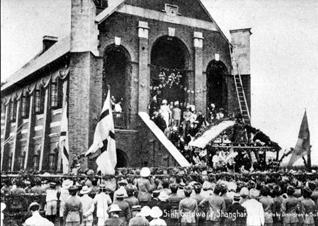
Above: The gurdwara in its original glory. Images below - The old gurdwara as it stands neglected today.


Travel
The Shanghai Sardars
by MEENA VATHYAM
Shanghai’s bounty of silk and opium offered rich prospects, attracting Western powers to operate trade centers. The treaty of Nanjing, the Opium Wars, European and American settlements, Jewish refugee influx, and the Japanese invasion provide detailed foreign influences and historical perspectives of a city, once referred to as Paris of the East or, alternately, the New York of the East.
The Shanghai International Settlement was formed and administered by multiple foreign powers, though the British maintained their hold, at least till 1930s. Unlike the colonies of Hong Kong and Weiheiwei, the Shanghai International Settlement always remained Chinese sovereign territory.
The lives and times of the Western inhabitants, be it police, traders or women is well documented.
Only the Sikh police, an important part of the Shanghai International Settlement, has hardly left any DNA. Walking their trail here has proven to be a very difficult task. What did they do for fun? Where did they spend time after work hours? Did they interact with their neighbors? Did they celebrate festivals?
Well, unfortunately the sparse citations about them come from online sites maintained by expatriate history buffs. Plus, meticulous research published by professors of history and scraps of information by Sikh bloggers.
The Sikhs were here to patrol the traffic and control the Chinese, thanks to their imperious physical appearance and soldierly skills. They were also relied upon for their expertise in riot control, a mob control method which originated in Shanghai. Derogatorily referred to as Hong Tou A-san, the red turbaned, bearded policemen were considered as the 3rd tier, lower than all Shanghai residents and nationalities of that time, including the Chinese. A-san is clever use of the Chinese term and loosely means the 3rd being; in this case, the Sikh police force deployed in Shanghai.
The salaries and service terms, however, were attractive, compared to the army and the Sikhs preferred to stay back and applied for jobs as watchmen for private firms and businesses. They were also part-time moneylenders acquiring an unsavory reputation for charging exorbitant rates.
But, random references provide a very narrow glimpse of the Sikh policemen from an employer’s or Chinese perspective. There is no documentation that reconstructs their life in Shanghai, apart from policing and moneylending.
They were not allowed to bring families to Shanghai. So, their adaptation to Shanghai lifestyle, activities, interaction with the locals on a social level, etc. are not chronicled. Unfortunately, their footprints are invisible.
The Shanghai City Guide lists one building as a gurudwara , a makeshift worship place but it is in a shabby and pathetic state. Contrast this with other historical buildings found in Shanghai. It could have easily been preserved as a symbol of history, but instead it has become an unhygienic and poorly maintained residence for some. The Sikh police force was not liked by the Chinese who considered them “slaves of slaves”.
The photographs are plenty, as the Sikhs were definitely a novelty in Shanghai.
Most of the Sikhs in Shanghai and other Indians left China by 1940s. Few who remained had to exit because they feared the effects of the Cultural Revolution. With that ended the Sikh sojourn to mainland China.
Interestingly, in present times, Shanghai has seen influx of Sikhs and other South Asians. They have converted residential space to offer gurdwara services, enabling Sikhs to offer prayers on a weekly basis.
If any readers are aware of names of the Sikh police force based in Shanghai, or have any information (including photos, documents, etc.) please contact the author at mvathyam@gmail.com
Acknowledgment: Dr Madhavi Thampi, Associate Professor, Department of East Asia Studies, Delhi University, author of ” Indians in China, 1800-1949″.
[Courtesy: Le Loop]
May 26, 2011
Conversation about this article
1: Malkiat Singh (Chandigarh, Punjab), May 26, 2011, 3:09 PM.
It's exactly this kind of research, study and documenting we need to be conducting on the many aspects of our history worldwide. Ms Vathyam has done a commendable job in digging out all this elusive history. Hope to see more from her pen! Thank you.
2: Gurinder Singh (Stockton, California, U.S.A.), May 27, 2011, 10:15 AM.
Sikhs of Shnaghai were also in the dairy farming business in a big way. Many settled in Hong Kong after the take-over by the communists. I once met a person whose name was Singh but looked like Chinese. I learned that his father was a Sikh and mother was Chinese. He had his siblings still living in Shanghai.
3: N.S. Khalsa (Orlando, Florida, U.S.A.), May 30, 2011, 11:04 PM.
In the movie, "Fearless" starring Jet Li, Sikhs soldiers or police men are seen marching at the end of the movie. Would surely be interesting to find out more. Perhaps the British who brought the Sikhs there might have military records on this time-period in China. The movie is based in the city of Tianjian, China.
4: Jagjit Singh (Hong Kong), August 18, 2011, 7:01 AM.
My uncle, Sardar Tara Singh, from village Chhola Sahib, was a policeman those days and he came to settle in Hong Kong. One of my cousin was born in Shanghai in 1952. If anyone is visiting Hong Kong, meet me and I can introduce you to some people who came to Hong Kong from Shanghai.
5: Meena Vathyam (Royersford, PA, U.S.A.), October 21, 2011, 3:50 AM.
Thank you, Mr. Jagjit Singh! Is it possible for me to communicate with your cousin/other elders? Would they be willing to share the history of the Sikhs in China? I would be very much obliged.
6: Gurdeep Singh (India), July 25, 2012, 2:14 PM.
Sat Sri Akal, Jagjit Singh ji. I am based in India and planning to apply for a Hong Kong QMAS visa. Is it possible to get any help during my early days of arrival, as I don't have any relative or friend in HK.
7: Jagjit Singh (Hong Kong), January 26, 2016, 8:12 AM.
Ms.M eena Vathyam and Bhai Gurdeep Singh ji, Sat Sri Akaal. I am sorry I did not read your messages earlier. My e-mail address is hamrita23@yahoo.com in case you still wish to contact me if you need more information. Or you can add me to whatsapp +852 96895862.


